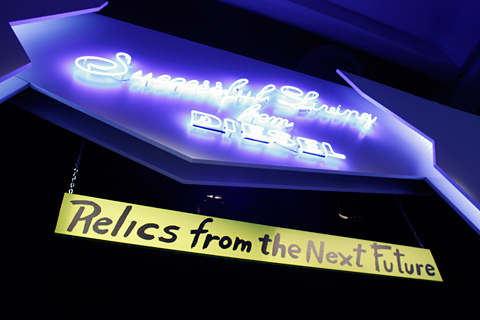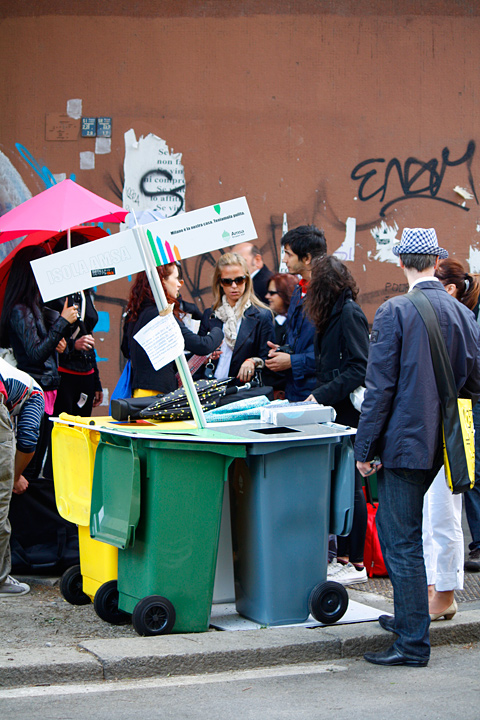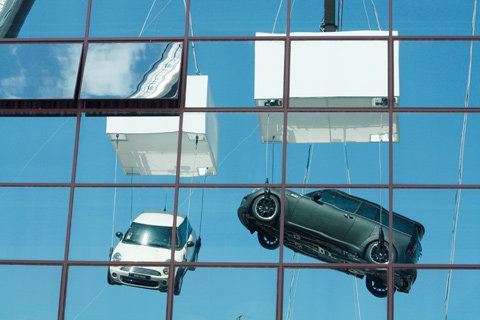Anybody traveling to Milan in April to see the furniture needs comb his way meticulously through the exhibition center itself, way out in the north-west, but cannot avoid visiting various highlights spread both isolated and concentrated across the city. There is less opportunity than ever before to visit even the most important spots, presentations, and exhibitions, or even to get something approaching a complete picture of both the saloni and the fuori. 5,300 journalists registered for the fair. Events are spreading like wildfire, the scene is imploding. Seeing and understanding design in Milan is nowadays primarily a logistical problem, as the local transport system is basically not equipped for transporting an additional 320,000 exhibition visitors on top of the city’s 1.3 million inhabitants. Whatever form of transport you opt for: the historical city resists hectic dashing from north to south and back again.
From an experiment to a solution
The result is a strict selection process and voluntary self-restriction. And visitors get a lasting sense of failing to achieve anything. Even after days they still feel that they have not seen anything. Like in a supermarket, returning visitors look for familiar places, hoping for surprises and for something new. Just like in a supermarket, however, the range on offer is constantly moved around, extended and optimized so that it will sell better. Until now, what has distinguished Milan as the international Mecca of the furnishing industry has been the chance to see, touch, try out and talk about things that were not available anywhere else. There are now three different types of design to be discovered, noted and assessed in Milan: firstly, its unusual presentation. Secondly, its experiments, something very different from serial production. Thirdly, its products that are ready to be sold. The focus here is on sales promotion, on advertising for brands, careers and ideas. This was not always the case. The cultural aspect of design, its critical, resistant side that helps to decode it and – however provisionally – offers solutions and concepts, was, for a long time, characteristic of the Milan scene.
Back in 1985 the young Roman architect Vittorio Magnago Lampugnani was still able to assert with some justification: “Milanese design is considered the best in the world, particularly fine, particularly elegant, particularly select.” At the same time, he did not neglect to mention the crises, turmoil and inner contradictions that characterized Italian design. For a long time the Triennale was one of the major scenes of the debate, not, like today, one location among many, but an overarching themed event that functioned as a search for orientation. At the ninth Triennale back in 1951, for example, the neo-rationalism of the post-War era was still a defining characteristic, for instance in the designs of Vico Magistretti and Franco Albini – to mention just two of the protagonists still in the public eye today. In this context, it is interesting that Albini’s hanging shelf “Veliero” (1940) and his simple armchair “Piccy” (1946) have now been reissued, by Cassina and Campeggi respectively. Later, the emphasis was more on artistic concepts. A few aficionados from all over the world would make the trip to Milan in the late summer, where they met up for a glass of wine and for intense discussions in the city’s shady courtyards.
Design as news
However, the 1980s marked the dawning of a new era. The presentations by the Memphis design group turned into a spectacle. “Anybody who saw ‘Memphis’ felt informed, impressed, inspired, brought up-to-date with new things and with a new trend, in short, initiated,” commented form, the, at the time still somewhat staid German design magazine, before raising an admonishing finger: “but is a piece of furniture no longer allowed to look like a piece of furniture if it wants to gain recognition? ... is the market so saturated that only the extremes count now?”
The city as a backdrop
A mania for staging products and orchestrating product presentations has turned the city upside down. Long-abandoned former industrial manufacturing sites dating from the 19th and 20th centuries, some of which were only starting to be redeveloped, became the scenes of impressive events, even though they were not yet described in these terms. It all started with the Milan fashion scene in 1983: Italian Vogue’s art director, Flavio Lucchini, and photographers Fabrizio Ferri used a former engine depot close to Stazione Genova in south-west Milan as a photo studio: Superstudio Più was born. Shortly afterwards, galleries took up residence in little shops. Small and large industrial wastelands opened up for events. The largely abandoned, desolate area between the station and the rail tracks in the south-east, between via Tortona, with industrial buildings, garages, workshops and little businesses in back courtyards stretching along it, and the naviglio grande, the canal in the south of the area, offered the greatest imaginable contrast to the glamorous world of fashion and design, growing up into the “Zona Tortona”. And whereas the fashion industry has always focused on exclusivity and on setting itself apart, the design brands opened themselves up to the residents of Milan and an international audience alike. The parties that Giulio Cappellini organized at Superstudio Più in the late 1990s were legendary. The Milanese “jeunesse dorée” smoked and drank and enjoyed itself into the night underneath the silver helium balloons on expensive, exclusive furniture that was subsequently unusable. A few meters away, in via Stendahl, designer Stefano Giovanoni has fixed up Riva Calzoni, which used to be a jet testing facility, for his own requirements. He now not only has his studio there, but also room for presentation events. This is where he first showed his Alessi bathroom collection. Shortly afterwards Giulio Cappellini said goodbye to his independent brand and was integrated into “Charme”, a private equity fund, which now presents his elegant furniture at the “Milano Design Village” on nearby via Savona. What was fascinating was a certain balance between brand manufacturers and experimental approaches, between mass appeal and criticism.
Transforming the industrial zones
“Transformation” and “evolution” are words that the magazine Interni – part of Sylvia Berlusconi’s media empire and professional events partner of the “fuori” – uses to describe the changes that both design and Milan have been through. Transformation and evolution have also taken hold of the Zona Tortona. The giant grounds that used to belong to the Ansaldo factory between via Savona and via Tortona have been bought by the city. And this looks set to start pulling in the crowds, as David Chipperfield is building a 45,500 square meter museum complex there, comprising a museum of non-European cultures, the CASVA Visual Arts Study Center and an archaeological museum. As long as two years ago, Matteo Thun put up a building complex on what used to be factory grounds at the western end of via Tortona, while at the eastern end Tadao Ando erected a building for Armani.
And so, Zona Tortona was created. For a few years now, the marketing of the district has been more professional, but this has not necessarily made its contents any more interesting. Even last year, visitors on the lookout for clever, inspiring experiments found the established projects boring, and claimed that Zona Tortona was dead. Since Superstudio Più, headed by its owner Gisella Borioli, has gone solo and is no longer being marketed, including PR, by a company known as DesignPartners, the latter has run out of money. And to add insult to injury, the company’s managing director Maurizio Ribotti was arrested after receiving, by courier to his office, a package containing 440 g of cocaine under dubious circumstances. “Zona Tortona” with its round red logo became the “Tortona Design Week” with a black factory silhouette. Only the Superstudios at via Tortona nos. 13 and 27 boasted some 112,000 visitors in 2011, which corresponds to one third of all visitors to the fair.
Out and about in the Tortona district
At Giovannoni’s on via Stendal, Tom Dixon set up a temporary restaurant, furnishing it with appropriate items of small furniture – from luminaires to chairs. One of the most impressive items at the “Milano Design Village” was the above-mentioned “Veliero” hanging shelf by Franco Albini and current designs by Nendo, who was indulging in his usual visibility games here. Next door, Dedon recreated a piece of the New York skyline. A perfect backdrop for the nest-like outdoor furniture by Lüneburg. Diagonally opposite, Paris-based Italian-Lebanese-Japanese architectural bureau DGT had it raining LED light and water for Toshiba.
And if there are any worth mentioning, one of the high points of the “temporary museum for new design”, for which Giulio Cappellini acted as an adviser, was the presentation of the new Diesel Home Collection (realized by Foscarini, Moroso and Zucchi). Well done, not too exciting and, at times, self-depreciating. Oh yes, and here curator Beppe Finessi is just explaining the Foscarini installation by Vicente Garcia Jiminez. Yes, it is nice to look at. Nevertheless: let’s just press on here. The upholstered furniture collection “Comforty “ from Poland is looking for a new identity under art director Tomek Rygalik. The company’s factory close to the town of Kalisz does in fact employ as many as 3,000 workers. After the show on “Young Creative Poland” by Miska Miller Lovegrove at the Triennale in 2010, “Comforty “ organized a workshop on classics of the future. Not too glamorous? That’s true. Instead: a design competition with Patricia Urquiola taking part, and with sober, realistic results by Polish and external designers.
Occupying considerably more space than in previous years, the image presented by Sweden was downright confusing in its multiplicity. “Swedish Love Stories” – organized by Svensk Form and designed by ‘no picnic’ – was devoted to the landscape of Västra Götaland. The kind of things to be expected here were grouped around a kind of loose house structure in the middle of the room: textiles, wood, glass and ceramics. This worked surprisingly well, allowing a large number of individual exhibitors to create a harmonious joint impression.
And that was about it at this location. Wait a minute, no it was not. A quick trip upstairs to Danish luminaire brand &tradition and to Inch-Furniture (Thomas Wütrich and Yves Raschle) from Switzerland, who fitted out the Swiss pavilion at Shanghai 2010. This company’s furniture looks like old familiar friends from the 1950s. However it is, in fact, rather more solid and has been produced using current manufacturing techniques. Swiss quality, rare in Milan. A new name: designer Frederic Dedelly with his table, “Papat”.
Bohemian Rhapsody
One of the tranquil locations worth a visit is via Tortona no. 31 with its rear courtyard. This is where e15 has its showroom. And Stefan Diez is showing additions to its range. A new armchair, for example, in a new format with a matching stool. Further to the back of the showroom by Gandia Blasco there is even an outdoor sofa by Diez on show. But: it’s not ready yet. Please do not take any pictures! (is anybody keeping to this?). Not ready yet: “Bohemian Rhapsody”, staged by Lasvit, a Czech glass manufacturer. (What immediately occurs to me is Freddie Mercury at the grand piano in a white suit; dancing slowly and close together!). As visitors can see from the stand, this company can construct glass objects of all sizes, culminating in the atrium at Tiffany’s in Beijing. Objects of all shapes, sometimes kitschy, sometimes high-end. Here at Zona Tortona visitors can admire a crystalline object by Mathieu Lehanneur, a frozen color explosion by Fabio Novembre and an ephemeral lighting object by Nendo. Less spectacular, but good: a Slovenian luminaire brand, Vertigo Bird, with, among other things, new designs by Matthias Hahn from London (“Jinn”) and Uli Budde from Berlin (“Balloon”).
What French design foundation VIA had to offer made an unusually gloomy impression. This year, the Carte Blanche, the foundation’s main prize, was awarded to Gaëlle Gabillet & Stéphane Villard, whose household items evoke an apocalyptic vision. Black holes for the home: disturbing, ironical and not particularly comforting.

 Air Vase by Torafu Architect for Neoreal Wonder Installation by Canon
Air Vase by Torafu Architect for Neoreal Wonder Installation by Canon
 Sekitei by Nendo for Cappellini
Sekitei by Nendo for Cappellini
 POH by Raphael Navot for Cappellini
POH by Raphael Navot for Cappellini
 Kai Linke for &tradition
Kai Linke for &tradition
 Shuffle Table MH1 by Mia Hamborg for &tradition
Shuffle Table MH1 by Mia Hamborg for &tradition
 At Inchfurniture
At Inchfurniture
 Diesel Home Collection
Diesel Home Collection
 Entrance at Zona Tortona
Entrance at Zona Tortona
 Mini Installation in Superstudio
Mini Installation in Superstudio
 Installation at Toshiba
Installation at Toshiba
 Architekturbüro DGT from Paris for Toshiba
Architekturbüro DGT from Paris for Toshiba
 Metamorphosis by Foscarini in Superstudio in Zona Tortona
Metamorphosis by Foscarini in Superstudio in Zona Tortona
 Metamorphosis by Foscarini
Metamorphosis by Foscarini
 Tom Dixons Restaurant in Via Stendhal
Tom Dixons Restaurant in Via Stendhal
 Etch by Tom Dixon
Etch by Tom Dixon
 Molo Design
Molo Design
 Veliero by Franco Albini for Cassina
Veliero by Franco Albini for Cassina
 Veliero by Franco Albini for Cassina
Veliero by Franco Albini for Cassina
 Diesel Home Collection
Diesel Home Collection
 Diesel Home Collection
Diesel Home Collection
 Zona Tortona
Zona Tortona

 Installation at Toshiba
Installation at Toshiba
